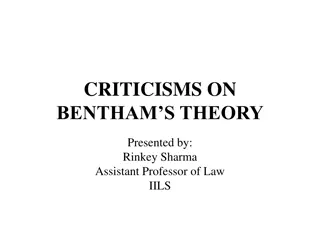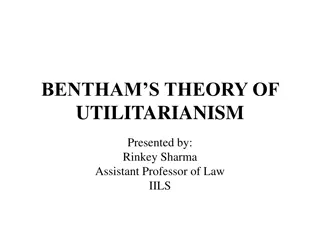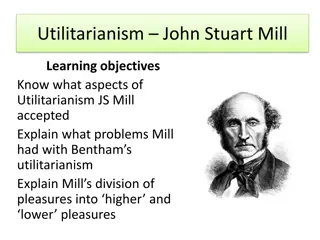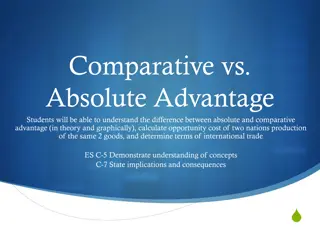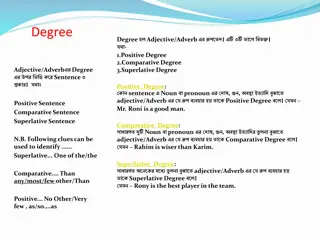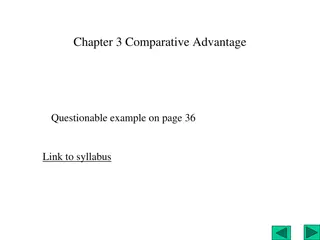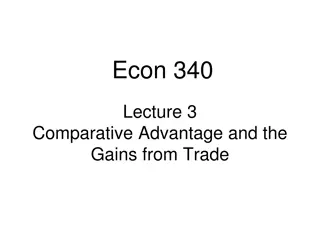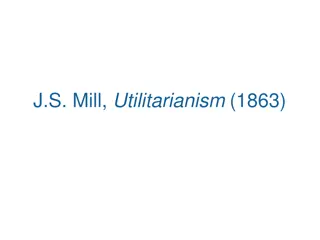Understanding Utilitarianism: A Comparative Analysis
Utilitarianism, as introduced by Jeremy Bentham, focuses on maximizing pleasure and minimizing pain to determine the ethical value of actions. Bentham's development of the hedonic calculus and the principle of utility are key components of this consequentialist theory. Influenced by hedonism and driven by a desire for social equality, Bentham aimed to create an ethical framework that prioritized the happiness of all individuals. This ethical approach evaluates actions based on their outcomes and impact on overall well-being, emphasizing the greatest happiness for the greatest number.
Download Presentation

Please find below an Image/Link to download the presentation.
The content on the website is provided AS IS for your information and personal use only. It may not be sold, licensed, or shared on other websites without obtaining consent from the author. Download presentation by click this link. If you encounter any issues during the download, it is possible that the publisher has removed the file from their server.
E N D
Presentation Transcript
Utilitarianism - Introduction Learning Objectives Know the hedonic calculus To explain the key features of utilitarianism To apply the hedonic calculus to an ethical dilemma HG start to evaluate act utilitarianism
The Big Pictures Bentham s Act Utilitarianism Specification Content Utilitarianism as a relativistic and consequentialist/teleological theory The principle of utility the greatest happiness for the greatest number based on the quantity of pleasure/happiness (maximise pleasure and minimise pain) and the seven criteria of the hedonic calculus (intensity, duration, certainty, remoteness, richness, purity and extent)
Benthams Utilitarianism If this is the answer what is the question? 1. Hedonism 2. If it brings about the greatest amount of pleasure and least amount of pain 3. The Hedonic Calculus 4. 7 5. A theory that is concerned with the end purpose or goal of an action
Questions 1. Which ancient ethical system focused on pleasure? 2. According to Bentham what makes an action good? 3. What name is given to Bentham s attempt to assess how we should behave? 4. How many factors in the HC? 5. What is a teleological theory?
Jeremy Bentham Bentham developed the ethical theory of utilitarianism. He believed that we should base our ethical decisions on the consequences of our actions. Actions are judged as a means to an end. Also that we should make all ethical decisions related to each unique event or situation. Although we could use a rule of thumb for example if we had been in the same situation before we could do the same action again.
Influences keep it brief Bentham was influenced by the ancient Greek ethical system of hedonism that made pleasure the sole good and pain the sole evil. He was also affected by the huge social and economic inequality that he witnessed in 18th London and wanted to develop an ethical theory that valued everyone's equal right to happiness, regardless of their situation or social class.
Principle of utility Bentham believed all ethical decisions should be based on the principle of utility, by this he meant the principle that approves or disapproves of every action according to the tendency it appears to have to increase or lessen the happiness of the person or group . Basically, he thought that we should choose the action that produces the greatest overall happiness for the greatest number. He found this phrase in the work by Priestley On Government . Bentham believed we should put the happiness of the community before the happiness of an individual.
Hedonic Calculus In chapter 4 of his Introduction to the Principles of Morals and Legislation Bentham explains his ideas for a hedonistic calculus. This could be used by individuals to calculate the value or utility of an action i.e. it s chances of producing happiness or pain. In the scientific enlightenment age it offered a way of calculating the happiness caused by a particular action, and made that the basis for deciding how to act.
Hedonic Calculus recap sheet Key Terms - Seven Criteria P R R I C E D
Hedonic Calculus Seven Criteria revision aide Purity Remoteness Richness Intensity Certainty Extent Duration
Application of Act Utilitarianism Work in pairs Read example 1 Vardy page 65-66 Attempt to apply the seven features of the Hedonic Calculus to the example Complete your example sheet and discuss with your partner. What would the act utilitarian response to the issue be? Extention AO2 prep example
Essay time! Correct these sentences 1. Jeremy Bentham was a man who lived a long time ago and he did not like the way some people had to live . . . 2. Utilitarimism is based on the principle of utality . . . 3. In this essay I am going to rite about . . . 4. Utilitarianism is a teleological ethical theory thought up by Jeremy Bentham Changes highlight/underline the problems.
Act . Act Utilitarianism- utilitarian methods should first arrive at specific actions which are considered to be moral or immoral and from these general rules can be deduced. It moves from specific cases to general principles a rule is not enforced if it would not lead to the greatest happiness. Act Utilitarianism would allow acts we would consider to be unacceptable.
Q.3 (a) Explain how ethical decisions can be made using Act Utilitarianism Imagine you have to write this essay on Utilitarianism Write a line of the essay, and then pass it on to the person next to you You then add lines to the paper which is passed to you Can we, as a group, help each other to get decent essay answer? When you get your own back, read it through, is there anything you still want to add? Read Thompson page 74 Key words teleological, consequentialist Origins 18th cent, social inequality Jeremy Bentham Pleasure/pain, Act utilitarianism, quantitative, hedonic calculus, p.r.r.i.c.e.d
Q.3 (a) Explain how ethical decisions can be made using Act Utilitarianism Act Utilitarianism: developed by Jeremy Bentham is based on the Principle of Utility (GHP) - Greatest happiness for greatest number (maximum pleasure, minimum pain for greatest number). The hedonic calculus is used to measure the quantity of happiness . The hedonic calculus contains seven criteria - intensity, duration, certainty, extent, remoteness, richness and purity. It puts the happiness/pleasure of others (as consequence of action) at the centre of decision making. Actions are not good or bad in themselves but should be judged according to outcomes or consequences. The theory is also relativistic and teleological. Expect exemplification (examples) as outlined in the level descriptors for higher level responses. [AO1 30]
Plenary Pictionary Key terms




